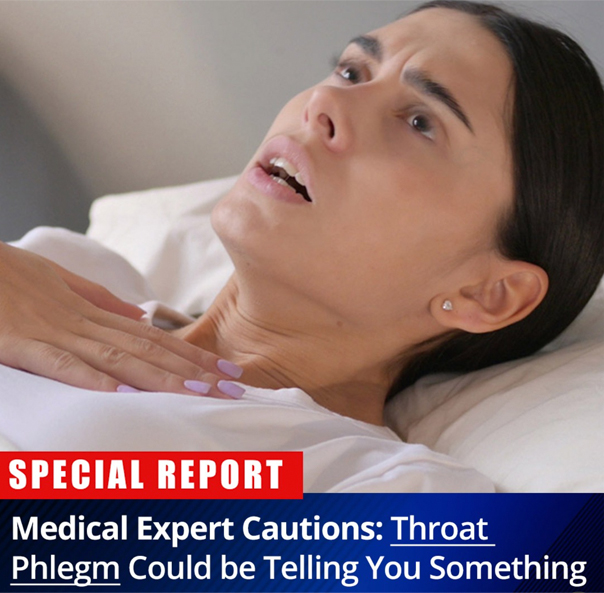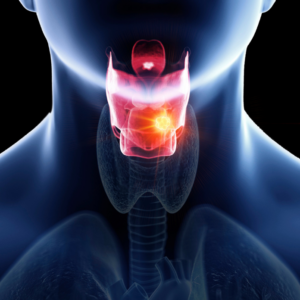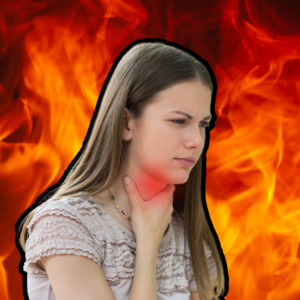Dr. Matthew Olesiak continues to make a significant impact in the medical field through his work at SANESolution and his dedication to evidence-based practices.
Throat Cancer: Symptoms, Causes, Diagnosis, Treatment & Prognosis
Unraveling the mystery of throat cancer can be a daunting task, but understanding its symptoms, causes, and treatments is essential to gain control over this potentially life-threatening condition.
Throat Cancer and better health
In this Throat Cleaner throat diseases blog post, we will dive deep into the world of throat cancer, providing valuable information to guide you on your journey toward better health. Let’s tackle beyond common throat infections in this article. If you have interests in more throat diseases for educational purposes, check out our Scarlet Fever article! Here we go!

- New Report Says Your Brain Could Be the Key to Reducing Phlegm Over 50
- Doctor's "Leave The Throat Phlegm Behind" Tutorial Goes Viral With People Over 50
- Can You Relieve Throat Phlegm and Coughing In 60 Seconds A Day? This Doctor Says Yes
- How To Banish Phlegm When 50+ (Do This Every Day)
Short Summary
- Throat cancer is a complex disease with various symptoms, risk factors, and treatments.
- Early detection of throat cancer symptoms can ensure successful treatment. Risk factors include tobacco use, alcohol consumption & HPV infection.
- Prevention strategies such as avoiding carcinogens & practicing good oral hygiene combined with regular checkups can reduce the risk of developing throat cancer. Prognosis varies depending on type/stage/age and health status.

Understanding Throat Cancer
Throat cancer is a complex disease that can affect various parts of the throat, including the pharynx, larynx, and oropharynx. These cancers are often linked to tobacco use, alcohol consumption, and human papillomavirus (HPV) infection, which can significantly increase the risk of developing throat cancer.
Understanding the different types of throat cancers and their symptoms is crucial for early detection and effective treatment.
Pharyngeal Cancer
Pharyngeal cancer, a type of head and neck cancer, originates in the pharynx, which is divided into three parts: the nasopharynx, oropharynx, and hypopharynx. This type of cancer can present with a variety of symptoms, including a painless lump in the upper neck, swelling of the neck, and difficulty swallowing.
The prognosis of pharyngeal cancer largely depends on the stage of the cancer at diagnosis, with a five-year relative survival rate of 86% for those diagnosed at an early stage.
Laryngeal Cancer
Laryngeal cancer affects the larynx, or voice box, and can impact a person’s ability to speak and breathe. Common symptoms of laryngeal cancer include voice changes, difficulty swallowing, and a persistent sore throat.
The prognosis for laryngeal cancer depends on factors such as the stage of the cancer and whether it has metastasized to other parts of the body.
Oropharyngeal Cancer
Oropharyngeal cancer involves the oropharynx, which is the middle part of the throat situated behind the mouth. Symptoms of oropharyngeal cancer may include a sore throat, difficulty swallowing, and alterations in vocal quality. Oropharyngeal cancer treatment options vary depending on the stage and severity of the disease.
The outlook for neck cancer depends on factors such as the stage of cancer and the patient’s overall health, with treatment options including surgery, radiation therapy, and chemotherapy.

Recognizing Throat Cancer Symptoms
It is crucial to be aware of the common symptoms of throat cancer, as early detection can significantly improve the chances of successful treatment. Many throat cancer symptoms may include voice changes, sore throat, difficulty swallowing, ear pain, and unexplained weight loss.
If you experience any of these symptoms for more than two weeks, it is essential to consult a healthcare provider to determine the underlying cause.
Voice Changes
Voice changes, such as hoarseness or loss of voice, can be an early sign of throat cancer. These vocal changes may be attributed to the tumor itself or to the treatments used to manage the condition, such as radiation or chemotherapy.
Treatment for voice changes associated with throat cancer can include speech therapy, vocal cord injections, and surgery.
Sore Throat
A persistent sore throat that does not improve with treatment may be indicative of throat cancer. While a sore throat can be caused by a variety of factors, such as viral or bacterial infections, allergies, dry air, smoking, and acid reflux, it is essential to seek medical advice if your sore throat persists for more than two weeks.
Thoracic cancer is a serious condition that can be life-threatening if not treated promptly.
Difficulty Swallowing
Difficulty swallowing, or dysphagia, can be a symptom of throat cancer. This condition can be attributed to a range of causes, such as neurological issues, muscular disorders, and cancer.
Treatment for difficulty swallowing may include taking smaller bites, chewing thoroughly, and eating more slowly, or working with a speech or occupational therapist to relearn how to swallow.

Identifying Risk Factors for Throat Cancer
To effectively prevent most throat cancers, it is important to understand the risk factors associated with the disease. Common risk factors for throat cancer include tobacco use, alcohol consumption, and HPV infection.
By limiting exposure to these risk factors, individuals can significantly reduce their chances of developing throat cancer.
Tobacco Use
Tobacco use, including smoking and smokeless tobacco, is a major risk factor for throat cancer. In fact, prolonged use of tobacco is the primary risk factor for all head and neck cancers, including throat cancer.
Quitting tobacco use can substantially decrease the risk of developing throat cancer and improve the effectiveness of treatment if cancer is already present.
Alcohol Consumption
Excessive alcohol consumption increases the risk of developing throat cancer. To reduce this risk, it is recommended to limit alcohol consumption to a maximum of two drinks per day for men and one drink per day for women.
Adopting strategies to reduce alcohol consumption, such as setting a limit on the amount of alcohol consumed, abstaining from binge drinking, and avoiding drinking on an empty stomach, can help prevent throat cancer.
Human Papillomavirus (HPV)
Infection with certain types of HPV can lead to oropharyngeal cancer. HPV is a sexually transmitted virus that affects the skin and mucous membranes. If the body is unable to effectively eliminate the HPV virus, it may result in the development of throat cancer.
Getting vaccinated against HPV can help reduce the risk of throat cancer caused by the virus.

Diagnosing Throat Cancer
Diagnosing throat cancer involves a combination of a physical examination, biopsy, and imaging tests. These diagnostic tools can help determine the type, stage, and location of the cancer, allowing healthcare providers to develop a personalized treatment plan for the patient.
The physical examination typically includes a visual inspection of the throat and neck area, as well as a physical examination of the throat and neck area.
Physical Examination
A physical examination can help identify any abnormalities in the throat or neck. During the examination, a physician will assess the mouth, throat, and neck, and may insert a gloved finger into the mouth to inspect hard-to-see areas.
This examination can provide valuable information for determining the presence of throat cancer.
Biopsy
A biopsy involves taking a tissue sample to check for the presence of cancer cells. This diagnostic procedure is typically low-risk and painless, and can provide precise information about the presence of cancer cells in the throat.
The results of a biopsy can help guide the formulation of an effective treatment plan for throat cancer.
Imaging Tests
Imaging tests, such as CT scans, MRIs, and PET scans, can help determine the extent and location of the cancer. These tests can provide detailed images of the throat and surrounding areas, allowing healthcare providers to assess the size and stage of the cancer and plan the most effective treatment approach.
By using imaging tests, healthcare providers can get a better understanding of the cancer and develop a treatment plan.

Throat Cancer Treatment Options
Throat cancer treatment options, which aim to treat throat cancer, include surgery, radiation therapy, and chemotherapy. The choice of treatment depends on factors such as the type and stage of the cancer, the patient’s overall health, and the location of the tumor.
By understanding the various treatment options available, patients and healthcare providers can work together to develop a personalized treatment plan for throat cancer.
Surgical Procedures
Surgical procedures can involve removing part of the pharynx, larynx, or oropharynx, depending on the size and location of the tumor. The extent of the surgical procedure is contingent upon the size and location of the tumor, and may include partial removal of the pharynx, larynx, or oropharynx.
Surgery can be an effective treatment option for throat cancer, but may also have an impact on a patient’s ability to speak and swallow.
Radiation Therapy
Radiation therapy can be used as a primary treatment for throat cancer or in combination with surgery or chemotherapy. This treatment involves the use of high-energy radiation to destroy cancer cells in the throat.
Radiation therapy can be an effective treatment option for throat cancer, but may also cause side effects such as fatigue, skin irritation, and difficulty swallowing.
Chemotherapy
Chemotherapy may be used alongside radiation therapy for larger tumors or to shrink tumors before surgery. This treatment involves the use of drugs to inhibit the growth of cancer cells, either by destroying them or by preventing them from dividing, ultimately aiming to kill cancer cells.
Chemotherapy can be an effective treatment option for throat cancer but may also cause side effects such as nausea, vomiting, hair loss, fatigue, and increased susceptibility to infections.
Prevention Strategies for Throat Cancer
Prevention strategies for throat cancer include avoiding tobacco and alcohol, practicing good oral hygiene, and getting vaccinated against HPV. By adopting these strategies, individuals can significantly reduce their risk of developing throat cancer and improve their overall health.
Regular check-ups with a doctor or dentist can also help to detect throat cancer in its early stages.
Throat Cancer Prognosis
The prognosis for throat cancer depends on factors such as the type of cancer, the stage at which it is diagnosed, the patient’s age, and their overall health. Survival rates for throat cancer can range from 52% to 83%, depending on these factors.
Early detection and adherence to a personalized treatment plan can significantly improve the prognosis for patients with throat cancer.
Summary
In conclusion, understanding throat cancer, its symptoms, causes, treatments, and prevention strategies is essential for maintaining good health and effectively managing the disease. By being proactive in recognizing symptoms, identifying risk factors, and seeking appropriate medical care, individuals can take control of their health and achieve the best possible outcome in their fight against throat cancer.
Frequently Asked Questions
What are the 1st signs of throat cancer?
The first signs of throat cancer are often a persistent sore throat, difficulty swallowing, and a change in voice. Other common symptoms include ear pain, a lump in the neck, and weight loss.
Is throat cancer very curable?
When detected early, throat cancer can be cured in around half of patients; however, it is not curable if the cancer has spread to other parts of the body.
Are there warning signs for throat cancer?
Yes, there are warning signs for throat cancer, such as hoarseness or a change in the voice, difficulty swallowing or feeling something caught in the throat, and a persistent sore throat.
These warning signs should not be ignored, as they can be indicative of a more serious underlying condition. Early detection is key to successful treatment, so it is important to seek medical advice if any of these symptoms are present.
What does Stage 1 throat cancer look like?
Stage 1 throat cancer typically presents as a non-painful nodular mass, which can interfere with swallowing and may cause a feeling of something stuck in the throat.
This can be a difficult symptom to diagnose, as it is often mistaken for other conditions such as acid reflux or allergies. Early diagnosis is key to successful treatment, so it is important to seek medical attention if you experience any of these symptoms.
What are the main risk factors for developing throat cancer?
Tobacco use, alcohol consumption, and HPV infection are the primary risk factors for developing throat cancer.

Dr. Matthew Olesiak continues to make a significant impact in the medical field through his work at SANESolution and his dedication to evidence-based practices.



